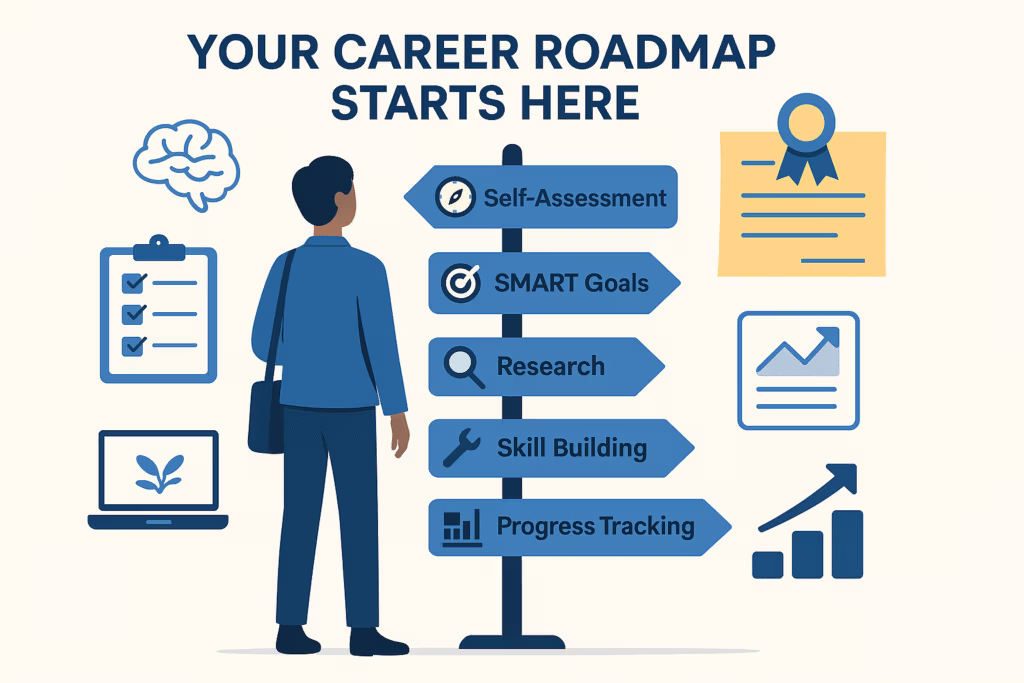😟 Do you feel like you’re drifting through your career without a clear direction? You’re not alone. Most professionals—whether fresh graduates or mid-career workers—don’t have a plan. Instead, they hop from one opportunity to another, hoping something eventually clicks.
❌ But without a roadmap, it’s easy to feel lost. You may end up stuck in roles you don’t enjoy, miss out on promotions, or fail to grow your potential.
✅ The good news? It’s never too late to take control.
This blog will walk you through a step-by-step process to create a practical, adaptable career roadmap that fits your goals, personality, and future aspirations.
📌 Here’s what we’ll cover:
- 🧭 Self-Assessment
- 🎯 Setting Clear Goals
- 🔍 Research & Benchmarking
- 🛠️ Action Planning
- 📊 Tracking & Adapting
- ⚠️ Pitfalls to Avoid
Let’s dive in.
Step 1: Self-Assessment (Know Your Starting Point)
Before you set your destination, you need to know where you’re starting from.
🛠️ Audit Your Skills
- 💻 List your hard skills (e.g., Excel, project management, coding)
- 🤝 Identify soft skills (e.g., communication, problem-solving, leadership)
- 📈 Use tools like a SWOT analysis to assess your Strengths, Weaknesses, Opportunities, and Threats
💡 Define Your Values & Interests
What really matters to you?
- ⚖️ Work-life balance
- 🌍 Social impact
- 🎨 Innovation and creativity
- 🛡️ Job security
📌 Example: A marketing professional might discover they enjoy data analysis more than writing copy, indicating a potential shift into marketing analytics.
💡 Pro Tip: Use career assessment tools like 16Personalities, CliftonStrengths, or CareerExplorer to better understand your preferences.
Step 2: Set Clear, Flexible Goals
A goal without a plan is just a wish. Let’s turn your wish into a roadmap.
🎯 Short-Term vs. Long-Term Goals
Use the SMART goal framework:
- ✅ Specific: “I want to become a certified data analyst.”
- 📏 Measurable: “I’ll complete the Google Data Analytics Certificate.”
- 🎯 Achievable: “I can dedicate 5 hours/week.”
- 🔗 Relevant: “It aligns with my interest in data.”
- ⏰ Time-bound: “Within the next 6 months.”
🔄 Avoid Rigidity
Stay open to lateral moves, industry shifts, or new passions.
“Aim for ‘VP of Sales in 5 years,’ but be open to a detour into product management if that excites you.”
🧠 Visualization Tip
Create a career vision board using Pinterest or Canva, or draw a mind map to connect your interests, skills, and goals.
Step 3: Research & Benchmarking
🔍 Clarity comes from context. Know what’s out there.
📈 Study Industry Trends
- 🚀 Which industries are growing? (e.g., AI, sustainability, digital health)
- 📚 What skills are in demand?
👥 Follow Role Models
- 🔎 Search LinkedIn profiles of professionals in roles you aspire to
- 📄 Note their career path, education, and key turning points
💰 Know the Numbers
Use tools like Glassdoor, LinkedIn Salary, or Payscale to:
- 💵 Understand salary ranges
- 🧾 Identify standard job requirements
📌 Example: “Sarah, a teacher, noticed edtech was booming. She upskilled in instructional design and landed a role in a startup within 6 months.”
Step 4: Break It Down into Actionable Steps
📅 A vision without execution is hallucination. Here’s how to make your plan actionable.
📆 Set Milestones
Break goals into timeframes:
- ⏳ 6-month: Complete a certification, update resume
- 📅 1-year: Land a new role, get a promotion
- 🧭 3-year: Build a personal brand or mentor others
📚 Develop Skills
Explore:
- 💻 Online courses: Coursera, LinkedIn Learning, Skillshare
- 🏅 Certifications: Google, PMI, AWS, etc.
- 🎤 Conferences & Webinars
🤝 Network Intentionally
- 📞 Conduct informational interviews
- 👥 Join relevant LinkedIn groups
- 🌐 Attend local meetups or virtual events
💡 Pro Tip: Schedule one networking activity per week.
Step 5: Track Progress & Adapt
🛣️ A career roadmap isn’t a one-and-done. It’s a living document.
📊 Review Quarterly
Ask yourself:
- ✅ What’s working?
- ❌ What’s not?
- 🔄 What’s changed in my interests or the industry?
🧭 Normalize Pivots
Changing your mind is not failure—it’s evolution.
“Mark spent 7 years in finance before pivoting to UX design. He’s never been happier.”
🧰 Use Tools
- 📋 Trello: Visual task management
- 🧠 Notion: All-in-one planner
- 📑 Google Sheets: Simple progress tracking
⚠️ Common Pitfalls to Avoid
🚫 1. Overplanning
Too much research = no action.
🚩 2. Ignoring Red Flags
Don’t stick to a toxic job just because it fits “the plan.”
😓 3. Comparison Trap
Your career path is uniquely yours. Don’t benchmark your chapter 2 against someone else’s chapter 10.
Conclusion: Your Future is a Strategy, Not a Guess
Creating a career roadmap isn’t about locking yourself into a rigid path—it’s about making intentional choices, knowing your direction, and giving yourself the tools to adapt as you grow.
Start today.
✅ Define your values
✅ Set your first SMART goal
✅ Talk to someone one step ahead of you
📣 Ready to take action?
Drop your career goal in the comments—or download our free Career Roadmap Template to get started.
🎁 Your future self will thank you.



